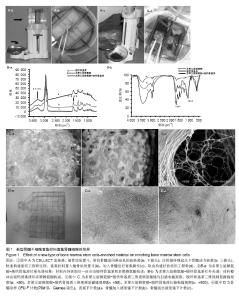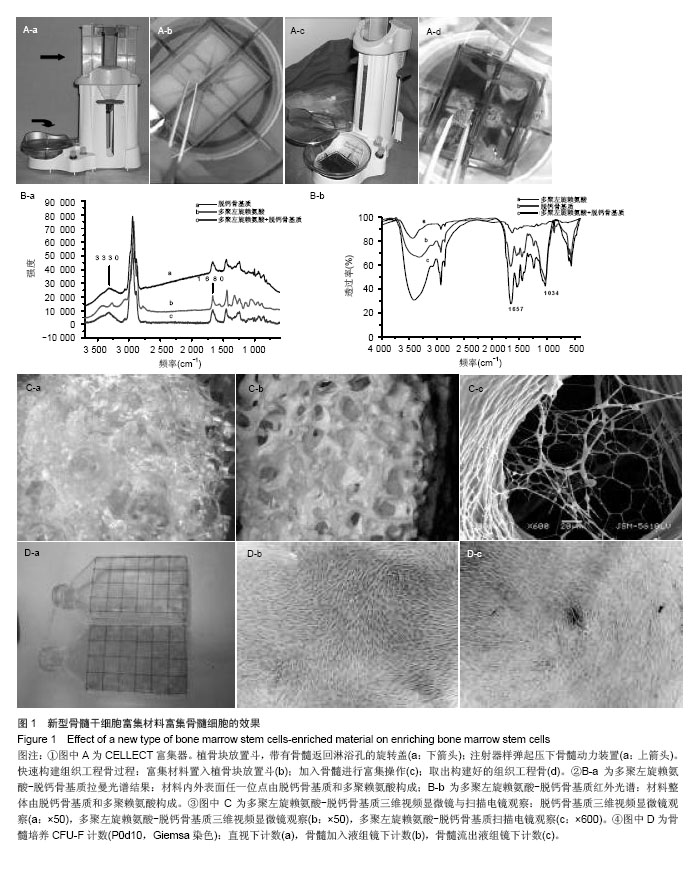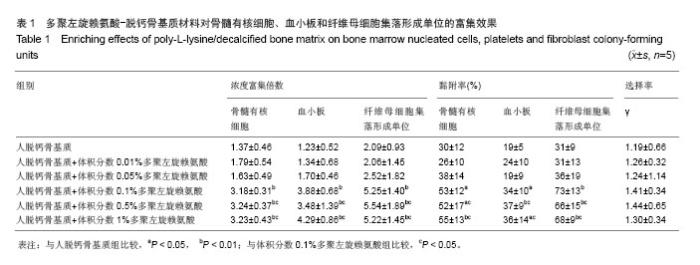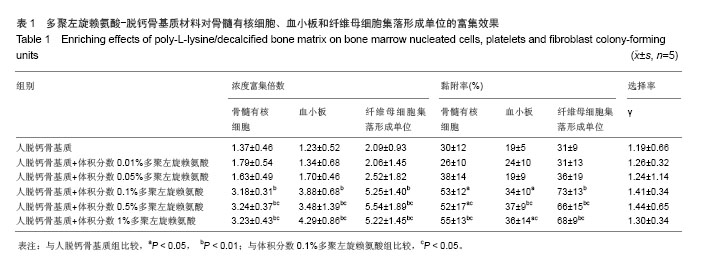Chinese Journal of Tissue Engineering Research ›› 2014, Vol. 18 ›› Issue (39): 6316-6322.doi: 10.3969/j.issn.2095-4344.2014.39.015
Previous Articles Next Articles
Effect of a new-type enriched material on enriching bone marrow stem cells by selective cell retention
Xu Zhen-dong 1, 2, Wang Guo-dong1, Liu Xi-ming1, Cai Xian-hua1, Xu Jian-zhong3
- 1 Department of Orthopedics, Wuhan General Hospital of Guangzhou Military Command, Wuhan 430070, Hubei Province, China; 2 Hubei University of Chinese Medicine, Wuhan 430060, Hubei Province, China; 3 Department of Orthopedics, Southwest Hospital, Third Military Medical University, Chongqing 400038, China
-
Online:2014-09-17Published:2014-09-17 -
Contact:Liu Xi-ming, M.D., Associate chief physician, Master’s supervisor, Department of Orthopedics, Wuhan General Hospital of Guangzhou Military Command, Wuhan 430070, Hubei Province, China -
About author:Xu Zhen-dong, Studying for master’s degree, Department of Orthopedics, Wuhan General Hospital of Guangzhou Military Command, Wuhan 430070, Hubei Province, China; Hubei University of Chinese Medicine, Wuhan 430060, Hubei Province -
Supported by:the National High Technology and Development Program of China (863 Program), No. 2006AA02A122; Natural Science Foundation of Hubei Province, No. 2008CDB215; Research Project of Wuhan Science and Technology Bureau, No. 2013060501010160
CLC Number:
Cite this article
Xu Zhen-dong, Wang Guo-dong, Liu Xi-ming, Cai Xian-hua, Xu Jian-zhong. Effect of a new-type enriched material on enriching bone marrow stem cells by selective cell retention[J]. Chinese Journal of Tissue Engineering Research, 2014, 18(39): 6316-6322.
share this article

2.1 新型骨髓干细胞富集材料富集骨髓细胞拉曼光谱检测结果 3 330 cm-1是脱钙骨基质特征性的VN-H(氮氢伸缩振动峰),1 680 cm-1是多聚左旋赖氨酸特征性的酰胺VC=O(碳氧伸缩振动峰),富集材料同时具备3 330 cm-1和1 680 cm-1两个峰,表明材料内外表面任一位点由脱钙骨基质和多聚赖氨酸构成,见图1B-a。 2.2 新型骨髓干细胞富集材料富集骨髓细胞红外光谱检测结果 1 034 cm-1是脱钙骨基质的磷酸VP-O(磷氧伸缩振动峰),1 657 cm-1是多聚左旋赖氨酸含酰胺的VC=O(碳氧伸缩振动峰),故脱钙骨基质+多聚左旋赖氨酸中 1 657 cm-1处峰增强,1 034 cm-1处峰不变。表明材料整体由脱钙骨基质和多聚赖氨酸构成,见图1B-b。 2.3 新型骨髓干细胞富集材料富集骨髓细胞孔径、孔隙率、表面及横断面超微结构变化 单纯脱钙骨基质具有透明天然骨海绵状三维网孔结构,孔隙率及孔隙相互连通率高,且孔隙内部有大量小孔隙相互连通. 多聚左旋赖氨酸-脱钙骨基质除上述特点外,还可见材料及孔隙表面有厚度为2-7 μm的乳白色多聚左旋赖氨酸覆盖,且在孔隙中形成更小的,其孔径为20-65 μm的网孔结构。 多聚左旋赖氨酸-脱钙骨基质与脱钙骨基质孔径均在200-500 μm之间分布较多,多聚左旋赖氨酸-脱钙骨基质孔径(412.73±160.29) μm,大部分孔与孔之间有100 μm左右小孔贯通,见图1C。"


2.4 新型骨髓干细胞富集材料富集骨髓细胞中骨髓有核细胞、血小板检测结果 通过SCR技术,骨髓中有核细胞由(9.31±2.07)×109 L-1浓缩至(30.28±12.34)×109 L-1;血 小板由(213±115)×109 L-1浓缩至(915±446)×109 L-1。与无多聚左旋赖氨酸修饰的脱钙骨基质比较,体积分数0.1%多聚左旋赖氨酸修饰的富集材料对人骨髓有核细胞浓度富集倍数为(3.18±0.31)倍,黏附率达(53±12)%;对人骨髓血小板富集倍数为(3.88±0.68)倍,黏附率达(34±10)%,差异均有显著性意义(P < 0.05),见表1。 2.5 新型骨髓干细胞富集材料富集骨髓细胞中纤维母细胞集落形成单位计数结果 与无多聚左旋赖氨酸修饰的脱钙骨基质比较,体积分数0.1%多聚左旋赖氨酸修饰的富集材料对人骨髓干细胞即纤维母细胞集落形成单位浓度富集倍数为(5.25±1.40)倍,黏附率达(73±13)%(P < 0.05), 选择率达1.41±0.34,具体细胞计数结构见图1D,表1。"

| [1]Malizos KN, Dailiana ZH, Innocenti M, et al. Vascularized bone grafts for upper limb reconstruction: defects at the distal radius, wrist, and hand. J Hand Surg Am. 2010;35(10):1710- 1718.
[2]Giannoudis PV, Chris-Arts JJ, Schmidmaier G, et al. What should be the characteristics of the ideal bone graft substitute? Injury. 2011;42(Suppl 2):S1-S2.
[3]Block JE. The role and effectiveness of bone marrow in osseous regeneration. Med Hypotheses. 2005;65(4):740-747.
[4]蓝旭,文益民,葛宝丰,等.骨髓基质干细胞复合纳米羟基磷灰石/聚乳酸修复节段性骨缺损[J].中国骨与关节损伤杂志, 2006, 21(10):797-800.
[5]Lee K, Goodman SB. Cell therapy for secondary osteonecrosis of the femoral condyles using the Cellect DBM System: a preliminary report. J Arthroplasty. 2009;24(1):43-48.
[6]孙伟,赵杰,郭开今,等.富集骨髓间充质干细胞用于兔腰椎横突间的融合[J].中国组织工程研究,2012,16(10):1752-1755.
[7]胡德新,朱博,应小樟,等.含自体富集骨髓干细胞松质骨移植修复兔关节软骨大面积缺损的实验研究[J].浙江中西医结合杂志, 2014,24(3):200-202.
[8]应小樟,石仕元,胡德新,等.自体骨软骨移植与含富集骨髓干细胞松质骨移植修复兔关节软骨缺损[J].中国中西医结合外科杂志, 2010,16(6):674-677.
[9]Mahmood TA, Shastri VP, Van Blitterswijk CA, et al. Tissue engineering of bovine articular cartilage within porous poly (ether-ester) copolymer scaffolds with different structures. Tissue Eng. 2005;11(7-8):1244-1253.
[10]Muschler GF, Matsukura Y, Nitto H, et al. Selective retention of bone marrow-derived cells to enhance spinal fusion. Clin Orthop Relat Res. 2005;(432):242-251.
[11]Maddox E, Zhan M, Mundy GR, et al. Optimizing human demineralized bone matrix for clinical application. Tissue Eng. 2000;6(4):441-448.
[12]刘曦明,许建中,陈庄洪,等.PLL-DBM支架材料富集骨髓有核细胞的效果评价[J].华南国防医学杂志,2008,22(2):12-14.
[13]刘曦明,许建中,陈庄洪,等.新型骨髓干细胞富集材料的制备及其表征研究[J].华南国防医学杂志,2008,22(2):9-11.
[14]Hernigou P, Poignard A, Manicom O, et al. The use of percutaneous autologous bone marrow transplantation in nonunion and avascular necrosis of bone. J Bone Joint Surg Br. 2005;87(7):896-902.
[15]李强,孙正义,严冬雪,等.脱钙骨基质材料的生物学表现:降解性能、孔隙率及其黏附性能特征[J].中国组织工程研究与临床康复,2007,11(31):6121-6124.
[16]冯万文,夏亚一,党跃修,等.同种异体脱钙骨基质的组织工程学特性[J].中国组织工程研究与临床康复,2010,14(51):9512-9516.
[17]Urist MR. Bone: formation by autoinduction. Science. 1965; 150(3698):893-899.
[18]Randolph MA, Anseth K, Yaremchuk MJ. Tissue engineering of cartilage. Clin Plast Surg. 2003;30(4):519-537.
[19]李志强,侯天勇,罗飞,等.自组装肽复合脱钙骨基质作为骨髓富集支架材料的实验研究[J].第三军医大学学报,2011,33(5): 441-444.
[20]徐蕴,肖琼,田铧,等.细胞外基质对大鼠MSCs生物学活性的影响[J].中国现代普通外科进展,2007,10(1):26-28.
[21]Gareia AJ, Reyes CD. Bio-adhesive surfaces to promote osteoblast differentiation and bone formation. J Dent Res. 2005;84(5):407-413.
[22]Qian L, Saltzman WM. Improving the expansion and neuronal differentiation of mesenchymal stem cells through culture surface modification. Biomaterials. 2004;25(7-8):1331-1337.
[23]Siwach RC, Sangwan SS, Singh R, et al. Role of percutaneous bone marrow grafting in delayed unions, non-unions and poor regenerates. Indian JM ed Sci. 2001; 55(6):326-336.
[24]刘瑞祥,陈琪,涂江虹,等.自体骨髓经皮注射移植治疗骨不连和骨延迟愈合的临床效果观察[J].实用临床医药杂志,2013,17(16): 104-105.
[25]唐昭惠,诸黎星,徐土炳,等.自体红骨髓注射治疗骨不连术后局灶性骨缺损[J].中国骨伤,2009,22(7)549-550.
[26]Connolly JF. Injectable bone marrow preparations to stimulate osteogenic repair. Clin Orthop Relat Res. 1995;(313):8-18.
[27]Brodke D, Pedrozo HA, Kaput TA, et al. Bone grafts prepared with selective cell retention technology heal canine segmental defects as effectively as autograft. J Orthop Res. 2006;24(5): 857-866.
[28]干耀恺,戴尅戎,张蒲,等.应用富集骨髓干细胞技术治疗骨缺损[J].中华骨科杂志,2006,26(11):721-727.
[29]Jacobsen K, Szczepanowski K, Al Zube L A, et al. The role of intraoperative bone marrow aspirate stem cell concentration as a bone grafting technique. Tech Foot Ankle Surg. 2008; 7(2): 84-89.
[30]Youssef J, Brodke D, Haynesworth S, et al. 98. Selective cell retention technology in spinal fusion. Spine. 2003;3(5 Suppl): 114-115.
[31]Al-Obaidi MM, Al-Bayaty FH, Al Batran R, et al. Protective effect of ellagic acid on healing alveolar bone after tooth extraction in rat-a histological and immunohistochemical study. Arch Oral Biol. 2014;59(9):987-999.
[32]Congiu T, Pazzaglia UE, Basso P, et al. Chemical etching in processing cortical bone specimens for scanning electron microscopy. Microsc Res Tech. 2014;77(9):653-660.
[33]Oest ME, Damron TA. Focal therapeutic irradiation induces an early transient increase in bone glycation. Radiat Res. 2014; 181(4):439-443.
[34]Dai L, He Z, Zhang X, et al. One-step repair for cartilage defects in a rabbit model: a technique combining the perforated decalcified cortical-cancellous bone matrix scaffold with microfracture. Am J Sports Med. 2014;42(3):583-591.
[35]Mack SA, Maltby KM, Hilton MJ. Demineralized murine skeletal histology. Methods Mol Biol. 2014;1130:165-183.
[36]Koistinen AP, Halmesmäki EP, Iivarinen JT, et al. Short-term exercise-induced improvements in bone properties are for the most part not maintained during aging in hamsters. Exp Gerontol. 2014;51:46-53.
[37]Fu WL, Zhou CY, Yu JK. A new source of mesenchymal stem cells for articular cartilage repair: MSCs derived from mobilized peripheral blood share similar biological characteristics in vitro and chondrogenesis in vivo as MSCs from bone marrow in a rabbit model. Am J Sports Med. 2014; 42(3):592-601.
[38]Yorgan T, Rendenbach C, Jeschke A, et al. Increased Col10a1 expression is not causative for the phenotype of Phex-deficient Hyp mice. Biochem Biophys Res Commun. 2013;442(3-4):209-213.
[39]Thambyah A, Broom ND. Further insight into the depth-dependent microstructural response of cartilage to compression using a channel indentation technique. Comput Math Methods Med. 2013;2013:358192.
[40]Li ST, Liu Y, Zhou Q, et al. A novel axial-stress bioreactor system combined with a substance exchanger for tissue engineering of 3D constructs. Tissue Eng Part C Methods. 2014;20(3):205-214.
[41]Bondarenko A, Angrisani N, Meyer-Lindenberg A, et al. Magnesium-based bone implants: immunohistochemical analysis of peri-implant osteogenesis by evaluation of osteopontin and osteocalcin expression. J Biomed Mater Res A. 2014;102(5):1449-1457.
[42]Ko CL, Chen WC, Chen JC, et al. Properties of osteoconductive biomaterials: calcium phosphate cement with different ratios of platelet-rich plasma as identifiers. Mater Sci Eng C Mater Biol Appl. 2013;33(6):3537-3544.
[43]Tang H, Wu B, Qin X, et al. Tissue engineering rib with the incorporation of biodegradable polymer cage and BMSCs/decalcified bone: an experimental study in a canine model. J Cardiothorac Surg. 2013;8:133.
[44]Krause M, Oheim R, Catala-Lehnen P, et al. Metaphyseal bone formation induced by a new injectable β-TCP-based bone substitute: a controlled study in rabbits. J Biomater Appl. 2014;28(6):859-868.
[45]Kimura Y, Kubo S, Koda H, et al. RNA analysis of inner ear cells from formalin fixed paraffin embedded (FFPE) archival human temporal bone section using laser microdissection--a technical report. Hear Res. 2013;302:26-31. |
| [1] | Zhang Tongtong, Wang Zhonghua, Wen Jie, Song Yuxin, Liu Lin. Application of three-dimensional printing model in surgical resection and reconstruction of cervical tumor [J]. Chinese Journal of Tissue Engineering Research, 2021, 25(9): 1335-1339. |
| [2] | Zeng Yanhua, Hao Yanlei. In vitro culture and purification of Schwann cells: a systematic review [J]. Chinese Journal of Tissue Engineering Research, 2021, 25(7): 1135-1141. |
| [3] | Xu Dongzi, Zhang Ting, Ouyang Zhaolian. The global competitive situation of cardiac tissue engineering based on patent analysis [J]. Chinese Journal of Tissue Engineering Research, 2021, 25(5): 807-812. |
| [4] | Wu Zijian, Hu Zhaoduan, Xie Youqiong, Wang Feng, Li Jia, Li Bocun, Cai Guowei, Peng Rui. Three-dimensional printing technology and bone tissue engineering research: literature metrology and visual analysis of research hotspots [J]. Chinese Journal of Tissue Engineering Research, 2021, 25(4): 564-569. |
| [5] | Chang Wenliao, Zhao Jie, Sun Xiaoliang, Wang Kun, Wu Guofeng, Zhou Jian, Li Shuxiang, Sun Han. Material selection, theoretical design and biomimetic function of artificial periosteum [J]. Chinese Journal of Tissue Engineering Research, 2021, 25(4): 600-606. |
| [6] | Liu Fei, Cui Yutao, Liu He. Advantages and problems of local antibiotic delivery system in the treatment of osteomyelitis [J]. Chinese Journal of Tissue Engineering Research, 2021, 25(4): 614-620. |
| [7] | Li Xiaozhuang, Duan Hao, Wang Weizhou, Tang Zhihong, Wang Yanghao, He Fei. Application of bone tissue engineering materials in the treatment of bone defect diseases in vivo [J]. Chinese Journal of Tissue Engineering Research, 2021, 25(4): 626-631. |
| [8] | Zhang Zhenkun, Li Zhe, Li Ya, Wang Yingying, Wang Yaping, Zhou Xinkui, Ma Shanshan, Guan Fangxia. Application of alginate based hydrogels/dressings in wound healing: sustained, dynamic and sequential release [J]. Chinese Journal of Tissue Engineering Research, 2021, 25(4): 638-643. |
| [9] | Chen Jiana, Qiu Yanling, Nie Minhai, Liu Xuqian. Tissue engineering scaffolds in repairing oral and maxillofacial soft tissue defects [J]. Chinese Journal of Tissue Engineering Research, 2021, 25(4): 644-650. |
| [10] | Xing Hao, Zhang Yonghong, Wang Dong. Advantages and disadvantages of repairing large-segment bone defect [J]. Chinese Journal of Tissue Engineering Research, 2021, 25(3): 426-430. |
| [11] | Chen Siqi, Xian Debin, Xu Rongsheng, Qin Zhongjie, Zhang Lei, Xia Delin. Effects of bone marrow mesenchymal stem cells and human umbilical vein endothelial cells combined with hydroxyapatite-tricalcium phosphate scaffolds on early angiogenesis in skull defect repair in rats [J]. Chinese Journal of Tissue Engineering Research, 2021, 25(22): 3458-3465. |
| [12] | Wang Hao, Chen Mingxue, Li Junkang, Luo Xujiang, Peng Liqing, Li Huo, Huang Bo, Tian Guangzhao, Liu Shuyun, Sui Xiang, Huang Jingxiang, Guo Quanyi, Lu Xiaobo. Decellularized porcine skin matrix for tissue-engineered meniscus scaffold [J]. Chinese Journal of Tissue Engineering Research, 2021, 25(22): 3473-3478. |
| [13] | Mo Jianling, He Shaoru, Feng Bowen, Jian Minqiao, Zhang Xiaohui, Liu Caisheng, Liang Yijing, Liu Yumei, Chen Liang, Zhou Haiyu, Liu Yanhui. Forming prevascularized cell sheets and the expression of angiogenesis-related factors [J]. Chinese Journal of Tissue Engineering Research, 2021, 25(22): 3479-3486. |
| [14] | Liu Chang, Li Datong, Liu Yuan, Kong Lingbo, Guo Rui, Yang Lixue, Hao Dingjun, He Baorong. Poor efficacy after vertebral augmentation surgery of acute symptomatic thoracolumbar osteoporotic compression fracture: relationship with bone cement, bone mineral density, and adjacent fractures [J]. Chinese Journal of Tissue Engineering Research, 2021, 25(22): 3510-3516. |
| [15] | Liu Liyong, Zhou Lei. Research and development status and development trend of hydrogel in tissue engineering based on patent information [J]. Chinese Journal of Tissue Engineering Research, 2021, 25(22): 3527-3533. |
| Viewed | ||||||
|
Full text |
|
|||||
|
Abstract |
|
|||||